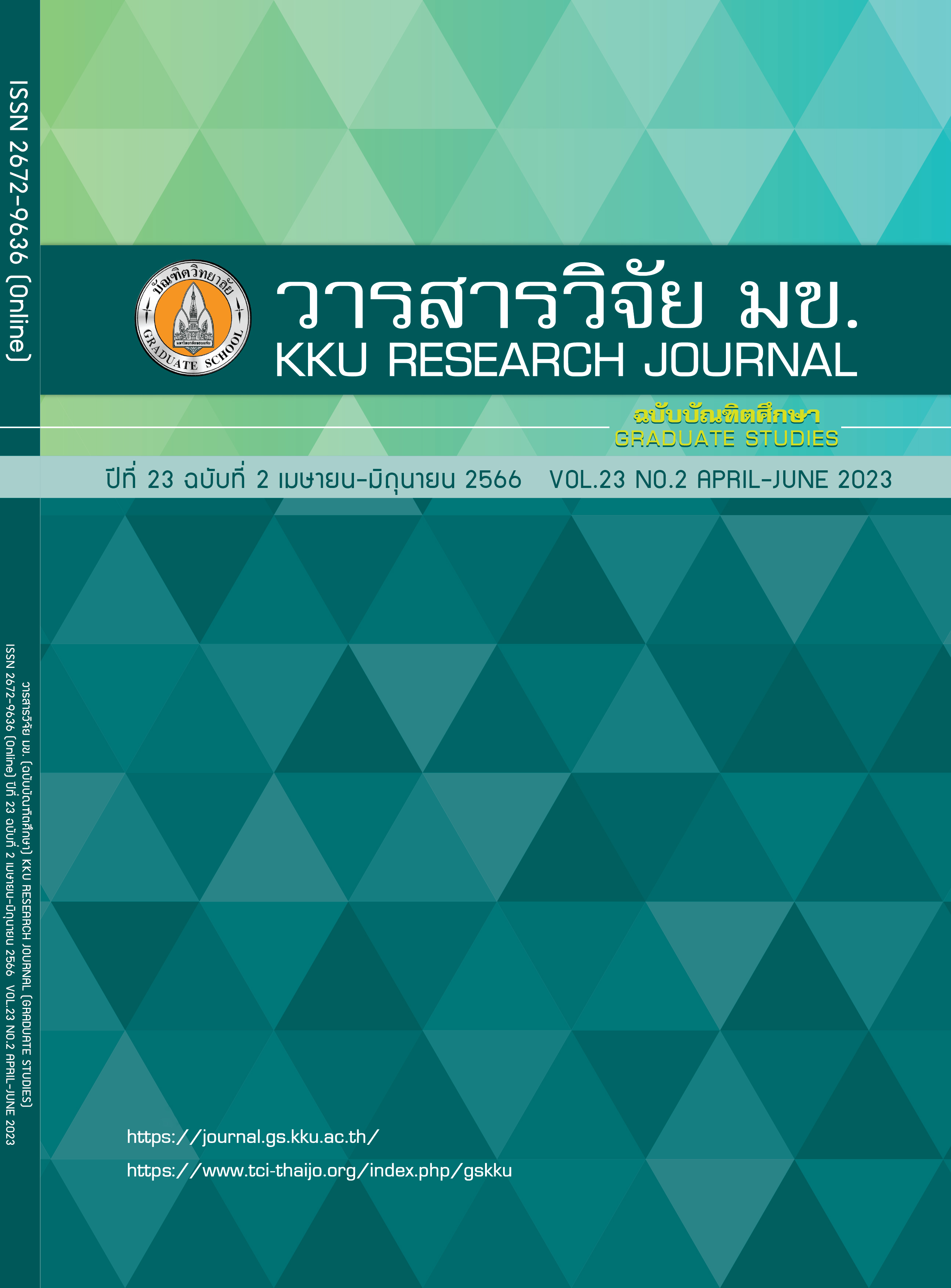The The Bth_i0249 Regulates Burkholderia thailandensis Biofilm Formation
Keywords:
Biofilm formation, B. thailandensis, MutationAbstract
Biofilm forming bacteria are a structured community of microorganisms enclosed in a self-produced polymatrix. Biofilm forming bacteria are responsible for a variety of chronic infections. Burkholderia pseudomallei is a causative agent of a broad spectrum of clinical symptoms collectively known as melioidosis. Biofilm formation and maturation in Burkholderia subspecies is poorly defined. Burkholderia thailandensis is a closely related subspecies to B. pseudomallei. Because of the broad similarities between these two bacteria, B. thailandensis is sometimes used as a model for study of B. pseudomallei. The aim of this study was to investigate the B. thailandensis biofilms phenotype in static and shear conditions using confocal laser scanning microscopy (CLSM). It was demonstrated that B. thailandensis was able to form mature biofilms over 96 hours that expressed multiple three-dimensional biofilm structures under both static and laminar-shear conditions. Using the microarray data from other Gram-negative bacteria that exhibited differential expression in biofilms as compared with free-living cells it was possible identify a candidate bth_i0249 gene of the YcgR protein superfamily of proteins that contains the PilZ conserved domain of B. thailandensis that plays a role in biofilm formation. Both the Δbth_i0249 and its conserved domain, Δbth_pilZ mutants, significantly reduced biofilm production both in static and laminar-shear conditions. Taken together, the bth_i0249 and its conserved domain, pilZ, are involved in biofilm formation.
References
Costerton JW, Cheng KJ, Geesey GG, Ladd TI, Nickel JC, Dasgupta M, et al. Bacterial biofilms in nature and disease. Annu Rev Microbiol. 1987;41:435-464.
Costerton JW, Lewandowski Z, Caldwell DE, Korber DR, Lappin-Scott HM. Microbial biofilms. Annu Rev Microbiol. 1995;49: 711-745.
O'Toole G, Kaplan HB, Kolter R. Biofilm formation as microbial development. Annu Rev Microbiol. 2000;54:49-79.
Costerton JW, Stewart PS, Greenberg EP. Bacterial biofilms: a common cause of persistent infections. Science. 1999 May 21;284(5418):1318-1322.
Donlan RM. Role of biofilms in antimicrobial resistance. ASAIO J. 2000 Nov-Dec;46(6):S47-52.
Hengge R. Principles of c-di-GMP signalling in bacteria. Nat Rev Microbiol. 2009 Apr;7(4):263-273.
Brett PJ, DeShazer D, Woods DE. Burkholderia thailandensis sp. nov., a Burkholderia pseudomallei-like species. Int J Syst Bacteriol. 1998 Jan;48 Pt 1:317-320.
Taweechaisupapong S, Kaewpa C, Arunyanart C, Kanla P, Homchampa P, Sirisinha S, et al. Virulence of Burkholderia pseudomallei does not correlate with biofilm formation. Microb Pathog. 2005 Sep;39(3):77-85.
Lopez CM, Rholl DA, Trunck LA, Schweizer HP. Versatile dual-technology system for markerless allele replacement in Burkholderia pseudomallei. Appl Environ Microbiol. 2009 Oct;75(20):6496-6503.
Bjarnsholt T, Jensen PO, Burmolle M, Hentzer M, Haagensen JA, Hougen HP, et al. Pseudomonas aeruginosa tolerance to tobramycin, hydrogen peroxide and polymorphonuclear leukocytes is quorum-sensing dependent. Microbiology. 2005 Feb;151 (Pt 2):373-383.
Leid JG, Shirtliff ME, Costerton JW, Stoodley P. Human leukocytes adhere to, penetrate, and respond to Staphylococcus aureus biofilms. Infect Immun. 2002 Nov;70(11):6339-6345.
Stapper AP, Narasimhan G, Ohman DE, Barakat J, Hentzer M, Molin S, et al. Alginate production affects Pseudomonas aeruginosa biofilm development and architecture, but is not essential for biofilm formation. J Med Microbiol. 2004 Jul;53(Pt 7):679-690.
Takenaka S, Iwaku M, Hoshino E. Artificial Pseudomonas aeruginosa biofilms and confocal laser scanning microscopic analysis. J Infect Chemother. 2001 Jun;7(2):87-93.
Korbsrisate S, Vanaporn M, Kerdsuk P, Kespichayawattana W, Vattanaviboon P, Kiatpapan P, et al. The Burkholderia pseudomallei RpoE (AlgU) operon is involved in environmental stress tolerance and biofilm formation. FEMS Microbiol Lett. 2005 Nov 15;252(2):243-249.
Sawasdidoln C, Taweechaisupapong S, Sermswan RW, Tattawasart U, Tungpradabkul S, Wongratanacheewin S. Growing Burkholderia pseudomallei in biofilm stimulating conditions significantly induces antimicrobial resistance. PLoS One. 2010;5(2):e9196.
Tunpiboonsak S, Mongkolrob R, Kitudomsub K, Thanwatanaying P, Kiettipirodom W, Tungboontina Y, et al. Role of a Burkholderia pseudomallei polyphosphate kinase in an oxidative stress response, motilities, and biofilm formation. J Microbiol. 2010 Feb;48(1):63-70.
Steinberger RE, Holden PA. Extracellular DNA in single- and multiple-species unsaturated biofilms. Appl Environ Microbiol. 2005 Sep;71(9):5404-5410.
Whitchurch CB, Tolker-Nielsen T, Ragas PC, Mattick JS. Extracellular DNA required for bacterial biofilm formation. Science. 2002 Feb 22;295(5559):1487.
Stoodley P, Debeer D, Lewandowski Z. Liquid flow in biofilm systems. Appl Environ Microbiol. 1994 Aug;60(8):2711-2716.
Stoodley P, Cargo R, Rupp CJ, Wilson S, Klapper I. Biofilm material properties as related to shear-induced deformation and detachment phenomena. J Ind Microbiol Biotechnol. 2002 Dec;29(6):361-367.
Amikam D, Galperin MY. PilZ domain is part of the bacterial c-di-GMP binding protein. Bioinformatics. 2006 Jan 1;22(1):3-6.
Downloads
Published
Issue
Section
License
Copyright (c) 2023 KKU Research Journal (Graduate Studies)

This work is licensed under a Creative Commons Attribution-NonCommercial-NoDerivatives 4.0 International License.



